海洋污染英文演讲稿ppt课件
- 格式:pdf
- 大小:2.16 MB
- 文档页数:14
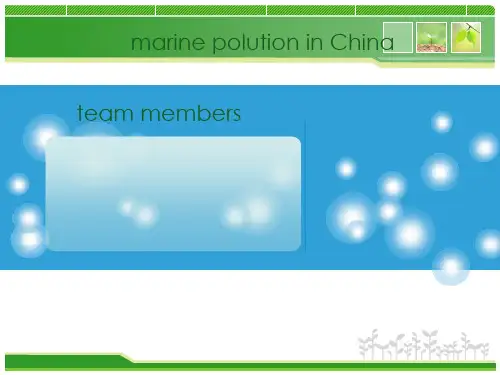
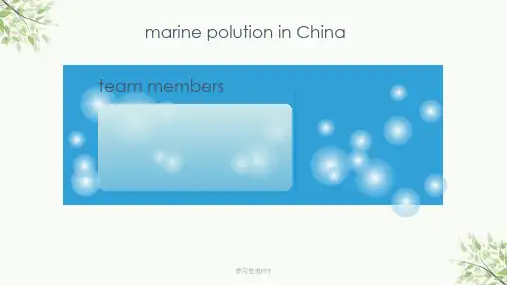
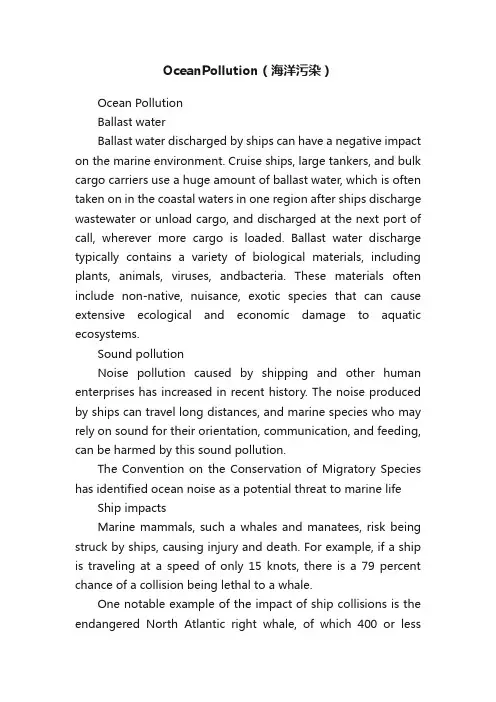
OceanPollution(海洋污染)Ocean PollutionBallast waterBallast water discharged by ships can have a negative impact on the marine environment. Cruise ships, large tankers, and bulk cargo carriers use a huge amount of ballast water, which is often taken on in the coastal waters in one region after ships discharge wastewater or unload cargo, and discharged at the next port of call, wherever more cargo is loaded. Ballast water discharge typically contains a variety of biological materials, including plants, animals, viruses, andbacteria. These materials often include non-native, nuisance, exotic species that can cause extensive ecological and economic damage to aquatic ecosystems.Sound pollutionNoise pollution caused by shipping and other human enterprises has increased in recent history. The noise produced by ships can travel long distances, and marine species who may rely on sound for their orientation, communication, and feeding, can be harmed by this sound pollution.The Convention on the Conservation of Migratory Species has identified ocean noise as a potential threat to marine life Ship impactsMarine mammals, such a whales and manatees, risk being struck by ships, causing injury and death. For example, if a ship is traveling at a speed of only 15 knots, there is a 79 percent chance of a collision being lethal to a whale.One notable example of the impact of ship collisions is the endangered North Atlantic right whale, of which 400 or lessremain. The greatest danger to the North Atlantic right whale is injury sustained from ship strikes. Between 1970 and 1999, 35.5 percent of recorded deaths were attributed to collisions. During 1999 to 2003, incidents of mortality and serious injury attributed to ship strikes averaged one per year. In 2004 to 2006, that number increased to 2.6. Deaths from collisions has become an extinction threat.Exhaust emissionsExhaust emissions from ships are considered to be a significant source of air pollution, with 18 to 30 percent of all nitrogen oxide and 9 percent of sulphur oxide pollution. The 15 biggest ships emit about as much sulphur oxide pollution as all cars combined. "By 2010, up to 40 percent of air pollution over land could come from ships." Sulfur in the air creates acid rain which damages crops and buildings. When inhaled the sulfur is known to cause respiratory problems and even increase the risk of a heart attack.According to Irene Blooming, a spokeswoman for the European environmentalcoalition Seas at Risk, the fuel used in oil tankers and container ships is high in sulfur and cheaper to buy compared to the fuel used for domestic land use. "A ship lets out around 50 times more sulfur than a lorry per metric tonne of cargo carried." Cities in the U.S. like Long Beach, Los Angeles, Houston, Galveston, and Pittsburgh see some of the heaviest shipping traffic in the nation and have left local officials desperately trying to clean up the air. Increasing trade between the U.S. and China is helping to increase the number of vessels navigating the Pacific and exacerbating many of the environmental problems. To maintain the level of growth China is currently experiencing, large amounts of grain are being shipped to China by the boat load.The number of voyages are expected to continue increasing.Oil spillsMost commonly associated with ship pollution are oil spills. While less frequent than the pollution that occurs from daily operations, oil spills have devastating effects. While being toxic to marine life,polycyclic aromatic hydrocarbons (PAHs), the components in crude oil, are very difficult to clean up, and last for years in the sediment and marine environment. Marine species constantly exposed to PAHs can exhibit developmental problems, susceptibility to disease, and abnormal reproductive cycles. One of the morewidely known spills was the Exxon V aldez incident in Alaska. The ship ran aground and dumped a massive amount of oil into the ocean in March 1989. Despite efforts of scientists, managers, and volunteers over 400,000 seabirds, about 1,000 sea otters, and immense numbers of fish were killed.SewageThe cruise line industry dumps 255,000 gallons of greywater and 30,000 gallons of blackwater into the sea every day. Blackwater is sewage, wastewater from toilets and medical facilities, which can contain harmful bacteria, pathogens,viruses, i ntestinal parasites, and harmful nutrients. Discharges of untreated or inadequately treated sewage can cause bacterial and viral contamination of fisheries and shellfish beds, producing risks to public health. Nutrients in sewage, such as nitrogen and phosphorus, promote excessive algal blooms, which consumes oxygen in the water and can lead to fish kills and destruction of other aquatic life. A large cruise ship (3,000 passengers and crew) generates an estimated 55,000 to 110,000 liters per day of blackwater wasteSolid wasteSolid wastegenerated on a ship includes glass, paper, cardboard, aluminium and steel cans, and plastics. It can be either non-hazardous or hazardous in nature. Solid waste that enters the ocean may become marinedebris, and can then pose a threat to marine organisms, humans, coastal communities, and industries that utilize marine waters. Cruise ships typically manage solid waste by a combination of source reduction, waste minimisation, and recycling. However, as much as 75 percent of solid waste is incinerated on board, and the ash typically is discharged at sea, although some is landed ashore for disposal or recycling. Marine mammals, fish, sea turtles, and birds can be injured or killed from entanglement with plastics and other solid waste that may be released or disposed off of cruise ships. On average, each cruise ship passenger generates at least two pounds of non-hazardous solid waste per day. With large cruise ships carrying several thousand passengers, the amount of waste generated in a day can be massive. For a large cruise ship, about 8 tons of solid waste are generated during a one-week cruise. It has been estimated that 24 percent of the solid waste generated by vessels worldwide (by weight) comes from cruise ships. Most cruise ship garbage is treated on board (incinerated, pulped, or ground up) for discharge overboard. When garbage must be off-loaded (for example, because glass and aluminium cannot be incinerated), cruise ships can put a strain on port reception facilities, which are rarely adequate to the task of serving a large passenger vessel.Bilge waterOn a ship, oil often leaks from engine and machinery spaces or from engine maintenance activities and mixes with water inthe bilge, the lowest part of the hull of the ship. Oil, gasoline, and by-products from the biological breakdown of petroleum products can harm fish and wildlife and pose threats to human health if ingested. Oil in even minute concentrations can kill fish or have various sub-lethal chronic effects. Bilge water also may contain solid wastes and pollutantscontaining high amounts of oxygen-demanding material, oil and other chemicals. A typical large cruise ship will generate an average of 8 metric tons of oily bilge water for each 24 hours of operation. To maintain ship stability and eliminate potentially hazardous conditions from oil vapors in these areas, the bilge spaces need to be flushed and periodically pumped dry. However, before a bilge can be cleared out and the water discharged, the oil that has been accumulated needs to be extracted from the bilge water, after which the extracted oil can be reused, incinerated, and/or offloaded in port. If a separator, which is normally used to extract the oil, is faulty or is deliberately bypassed, untreated oily bilge water could be discharged directly into the ocean, where it can damage marine life.A number of cruise lines have been charged with environmental violations related to this issue in recent years。
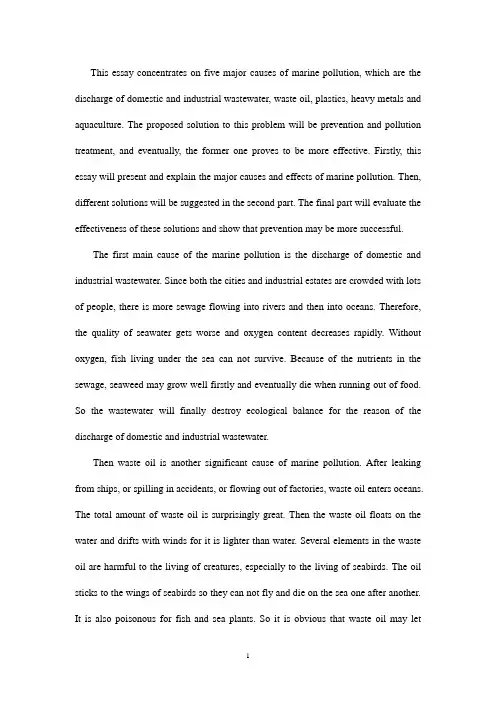
This essay concentrates on five major causes of marine pollution, which are the discharge of domestic and industrial wastewater, waste oil, plastics, heavy metals and aquaculture. The proposed solution to this problem will be prevention and pollution treatment, and eventually, the former one proves to be more effective. Firstly, this essay will present and explain the major causes and effects of marine pollution. Then, different solutions will be suggested in the second part. The final part will evaluate the effectiveness of these solutions and show that prevention may be more successful.The first main cause of the marine pollution is the discharge of domestic and industrial wastewater. Since both the cities and industrial estates are crowded with lots of people, there is more sewage flowing into rivers and then into oceans. Therefore, the quality of seawater gets worse and oxygen content decreases rapidly. Without oxygen, fish living under the sea can not survive. Because of the nutrients in the sewage, seaweed may grow well firstly and eventually die when running out of food. So the wastewater will finally destroy ecological balance for the reason of the discharge of domestic and industrial wastewater.Then waste oil is another significant cause of marine pollution. After leaking from ships, or spilling in accidents, or flowing out of factories, waste oil enters oceans. The total amount of waste oil is surprisingly great. Then the waste oil floats on the water and drifts with winds for it is lighter than water. Several elements in the waste oil are harmful to the living of creatures, especially to the living of seabirds. The oil sticks to the wings of seabirds so they can not fly and die on the sea one after another. It is also poisonous for fish and sea plants. So it is obvious that waste oil may letmany creatures to run into danger of dying out.The third major cause of marine pollution is plastics. Plastics are the main solid pollutants and people treat the oceans like a giant dustbin to pour plastics in. Kusui and Noda’s research showed that in the seashore of Japan, if there are 100 waste items thrown by people, 73 items are plastics, and the plastic litter equals 53.8% of the total litter of wastes. In the neighbouring Russia, the statistics are 55 items and 23.4% respectively (Islam, 2004).[1] The plastics can block the propeller of ships, and may cause enormous accident. Plastics floating in the oceans can also cause lack of oxygen and have the similar effects, preventing respiration of creatures, as the sewage does. When the plastics break down in the oceans, they can be toxic to marine plants and animals. Therefore, plastics are not only harmful to ships sailing in the oceans and mankind, but also to other creatures living in the seas.Heavy metals are the fourth main cause of the environment problem. There are various sorts of heavy metals contained in water from factories. They go into the oceans through rivers or water run-off. Then they are eaten by fish and begin to accumulate in their bodies. When these fish are caught by us human beings, heavy metals enter our bodies and make us ill. Heavy metals can cause serious diseases.Aquaculture is the final major cause to marine pollution. People usually cultivate fish and other marine life for food. But the foods which they use to feed marine life consequently harm the marine environment where there are people live around. It is because these foods are organic matter and will become rotten in the oceans gradually. The quality of seawater is reduced by this kind of substance and the marine life livingin this ocean area and adjacent ocean area will die. Thus, aquaculture will cause harm to the quality of seawater of large areas of oceans.There are two main solutions to the marine pollution problem. Prevention comes out first. It is suggested that governments should perfect new intendance system of protecting the quality of water that we should make water completely clean before it is discharged to the oceans. It is also necessary to establish laws to keep the conduct of people and enterprises, and develop cooperation among different countries. The second main solution is pollution treatment, which contains setting up treatment plants and planting trees. In Kocasoy, Mutlu, and Alagöz’s study (2008), [2]these solutions can reduce the discharge of domestic and industrial wastewater as well as improve the quality of seawater. Since trees are able to make soil secure and hold back water from running off, they can be planted in the crowded cities and factories which cause marine pollution. Treatment plants are used to cleanse the seawater.Considering the advantages and disadvantages of the two solutions, prevention of marine pollution will be more effective to solve the problem. In one hand, prevention is the most essential theme of environmental management. The monitoring of water quality can be put into practice in advance to prevent damage to ocean environment. To improve attitudes of people and enterprises towards pollution will obviously be helpful and it is feasible to bringing these limits to maintain the marine environment in good condition. In the other hand, always firstly polluting the marine environment and then taking counter-measures as treatment is irresponsible behaviour. Although these measures can reduce pollution to some extent, the disastrousconsequences may have already existed, and marine pollution will continually come into being and never end. Consequently, prevention is much better in solving the pollution problem.This essay considers the main causes and effects of marine pollution. The five causes are the discharge of domestic and industrial wastewater, waste oil, plastics, heavy metals and aquaculture. They can destroy the ecological balance, endanger many creatures of dying out, harm ships, human beings and other creatures, cause serious diseases to mankind, and cause harm to the quality of seawater of large areas of oceans. The solutions are prevention and pollution treatment. The prevention of marine pollution is proved to be more effective than pollution treatment because it can basically solve this problem and maintain the marine environment in a good condition. In my opinion, it is a challenge for governments to take proper measures to prevent people continuing polluting behaviour. However, there is still a long way to go in the future.(word count = 1151 words)Reference[1] Islam, M. S. & Tanaka, M., (2004) Impacts of pollution on coastal and marine ecosystems including coastal and marine fisheries and approach for management: a review and synthesis. Marine Pollution Bulletin, 48(7-8), P.624-649[2] Kocasoy, G., Mutlu, H. İ., Alagöz B. A. Z., (2008) Prevention of marineenvironment pollution at the tourism regions by the application of a simple method for the domestic wastewater. Desalination, 226(1-3), P.21-37。
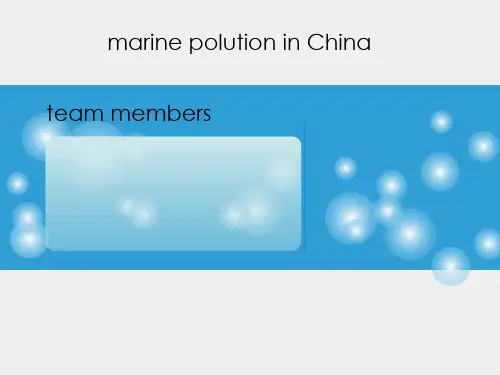
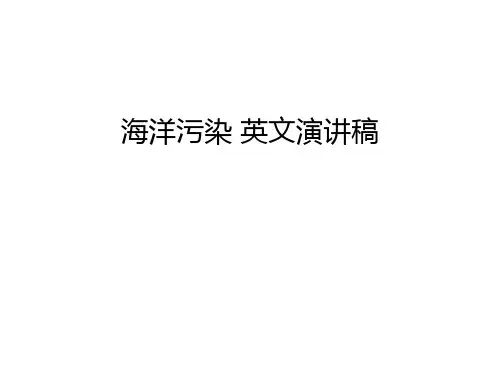
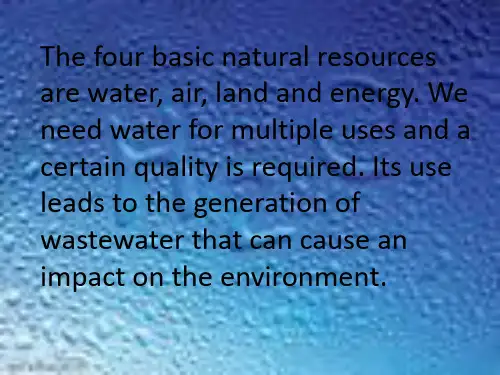
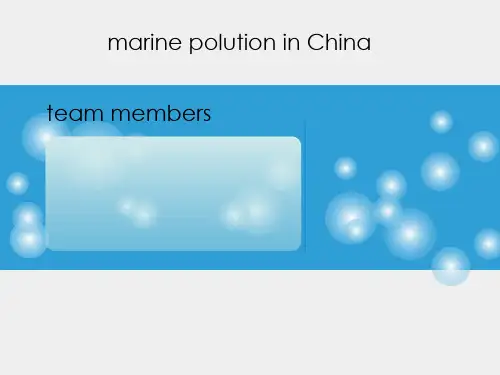
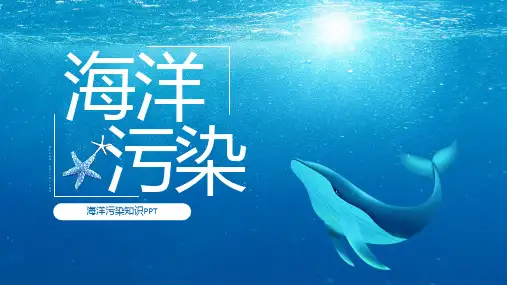
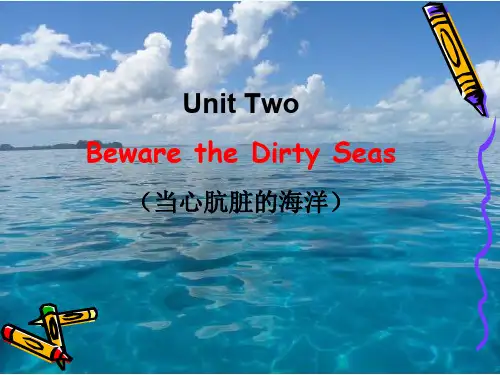
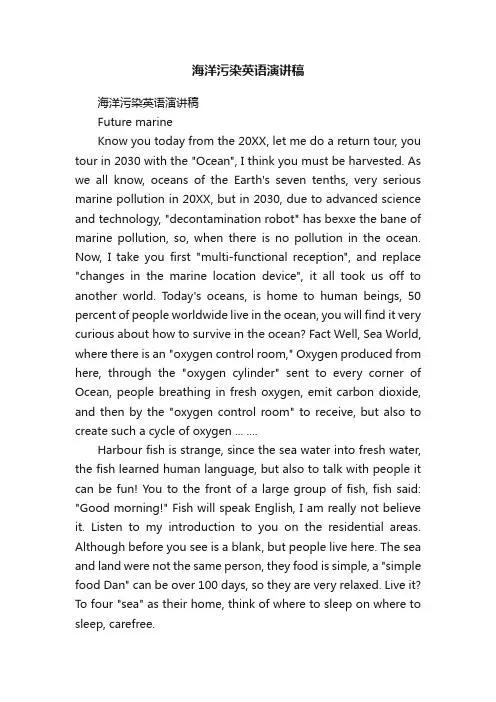
海洋污染英语演讲稿海洋污染英语演讲稿Future marineKnow you today from the 20XX, let me do a return tour, you tour in 2030 with the "Ocean", I think you must be harvested. As we all know, oceans of the Earth's seven tenths, very serious marine pollution in 20XX, but in 2030, due to advanced science and technology, "decontamination robot" has bexxe the bane of marine pollution, so, when there is no pollution in the ocean. Now, I take you first "multi-functional reception", and replace "changes in the marine location device", it all took us off to another world. T oday's oceans, is home to human beings, 50 percent of people worldwide live in the ocean, you will find it very curious about how to survive in the ocean? Fact Well, Sea World, where there is an "oxygen control room," Oxygen produced from here, through the "oxygen cylinder" sent to every corner of Ocean, people breathing in fresh oxygen, emit carbon dioxide, and then by the "oxygen control room" to receive, but also to create such a cycle of oxygen ... ....Harbour fish is strange, since the sea water into fresh water, the fish learned human language, but also to talk with people it can be fun! You to the front of a large group of fish, fish said: "Good morning!" Fish will speak English, I am really not believe it. Listen to my introduction to you on the residential areas. Although before you see is a blank, but people live here. The sea and land were not the same person, they food is simple, a "simple food Dan" can be over 100 days, so they are very relaxed. Live it? To four "sea" as their home, think of where to sleep on where to sleep, carefree.Then, you visit the Royal Palace, Park ... ... must have felt very grand, magnificent it! Perhaps you worry about, so many people living in the seabed, the environment will not occur the problem? Not. Harbour achieved without factory, but there are production. And no worse than the production of the land, because we row down the waste land, water, through the "decontamination robot" "pass" "make the robot" for processing, making available all kinds of things ... ... strange, wonderful sea world tour finished, how? I amsure you will feel the power of science is so magical.。